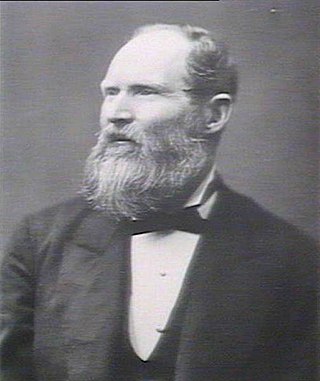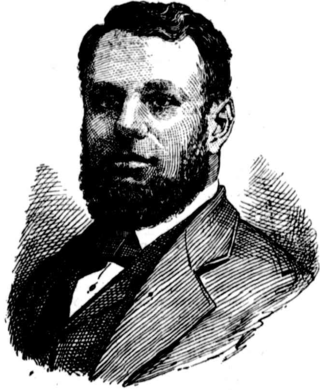Related Research Articles

James Squire Farnell was an Australian politician and Premier of New South Wales. Farnell was a hard-working legislator who gave much study to the land question and also tried hard for some years to pass a bill for the regulation of contagious diseases.

Canterbury is an electoral district of the Legislative Assembly in the Australian state of New South Wales, currently represented by Sophie Cotsis of the Labor Party.
Cumberland (North Riding) was an electoral district of the Legislative Assembly in the Australian state of New South Wales from 1856 to 1859, in Cumberland County, which includes Sydney. It included all of the county north of Parramatta Road and the Great Western Highway, except for the urban electorates of Sydney (City), Sydney Hamlets, Parramatta and Cumberland Boroughs, which included Richmond and Windsor. It elected two members simultaneously, with voters casting two votes and the first two candidates being elected. It was abolished in 1859 and the district was divided between Central Cumberland, Windsor, Nepean and St Leonards.
Cumberland (South Riding) was an electoral district of the Legislative Assembly in the Australian state of New South Wales from 1856 to 1859, in the rural part of Cumberland County, which includes Sydney. It included all of the county south of Parramatta Road and the Great Western Highway, except for the urban electorates of Sydney (City), Sydney Hamlets, Parramatta and Cumberland Boroughs, which included Liverpool and Campbelltown. It elected two members simultaneously, with voters casting two votes and the first two candidates being elected.
North Eastern Boroughs was an electoral district of the Legislative Assembly in the Australian state of New South Wales from 1856 to 1859, that included the towns of Newcastle, Stockton and Raymond Terrace. It was partly replaced by the electoral district of Newcastle and the electoral district of Hunter.
Cumberland Boroughs was an electoral district of the Legislative Assembly in the Australian state of New South Wales from 1856 to 1859, consisting of the Cumberland County towns of Richmond, Windsor, Liverpool and Campbelltown, but not the surrounding rural areas, which were in Cumberland and Cumberland. The district was abolished in 1859, with Richmond and Windsor forming the new electorate of Windsor, Campbelltown was included in Narellan and Liverpool became part of Central Cumberland.
Members of the New South Wales Legislative Assembly who served in the second parliament of New South Wales held their seats from 1858 to 1859. The Speaker was Sir Daniel Cooper.
Members of the New South Wales Legislative Assembly who served in the eighth parliament of New South Wales held their seats from 1874 to 1877. The 1874–75 election was held between 8 December 1874 and 12 January 1875 with parliament first meeting on 27 January 1875. There were 72 members elected for 52 single member electorates, 6 two member electorates and 2 four member electorates. During this parliament the number of graduates of Sydney University exceeded 100 and the seat of University of Sydney was created. The maximum term of this parliament was 3 years and the assembly was dissolved after 34 months. Premiers during this parliament were Sir John Robertson 9 February 1875 till 22 March 1877 and from 17 August 1877 and Sir Henry Parkes 22 March 1877 till 17 August 1877. The Speaker was William Arnold until his death on 1 March 1875 and then George Allen.
Members of the New South Wales Legislative Assembly who served in the 11th parliament of New South Wales held their seats from 1882 to 1885. Elections for the eleventh Legislative Assembly were held between 30 November and 21 December 1882 with parliament first meeting on 3 January 1883. The Assembly was expanded to 113 members elected in 40 single member electorates, 26 two member electorates, 3 three member electorate and 3 four member electorates. The parliament had a maximum term of 3 years and was dissolved on 7 October 1885 after 33 months. The Premiers during this parliament were Sir Alexander Stuart until 7 October 1885 and then George Dibbs. The Speaker was Edmund Barton.
Canterbury, an electoral district of the Legislative Assembly in the Australian state of New South Wales has had two incarnations, from 1859 to 1920 and 1927 to the present.

Varney Parkes was an Australian politician, architect and son of Henry Parkes.

Sir John Lackey was a magistrate and politician in colonial New South Wales, President of the New South Wales Legislative Council 1892 to 1903.

Andrew Hardie McCulloch was an Australian solicitor and politician.
Cumberland Boroughs, an electoral district of the Legislative Assembly in the Australian state of New South Wales was created in 1856 and abolished in 1859.
Cumberland North Riding, an electoral district of the Legislative Assembly in the Australian state of New South Wales was created in 1856 and abolished in 1859.
Cumberland South Riding, an electoral district of the Legislative Assembly in the Australian state of New South Wales was created in 1856 and abolished in 1859.
Central Cumberland, an electoral district of the Legislative Assembly in the Australian state of New South Wales was created in 1859 and abolished in 1894.
A by-election was held for the New South Wales Legislative Assembly electorate of Central Cumberland on 14 May 1888 because of the resignation of Andrew McCulloch who was facing financial difficulties. He announced his intention to recontest the seat at the by-election, even though he decided not to stand.
A by-election was held for the New South Wales Legislative Assembly electorate of Central Cumberland on 22 June 1889 because of the death of John Linsley.
St Leonards, an electoral district of the Legislative Assembly in the Australian state of New South Wales was created in 1894 and abolished in 1904.
References
- 1 2 "Mr Varney Parkes (1859-1935)". Former members of the Parliament of New South Wales . Retrieved 16 October 2011.
- ↑ "Writ of election: Central Cumberland". New South Wales Government Gazette . No. 143. 2 March 1888. p. 1625. Retrieved 25 August 2020– via Trove.
- ↑ Green, Antony. "March 1888 Central Cumberland by-election". New South Wales Election Results 1856-2007. Parliament of New South Wales . Retrieved 25 August 2020.